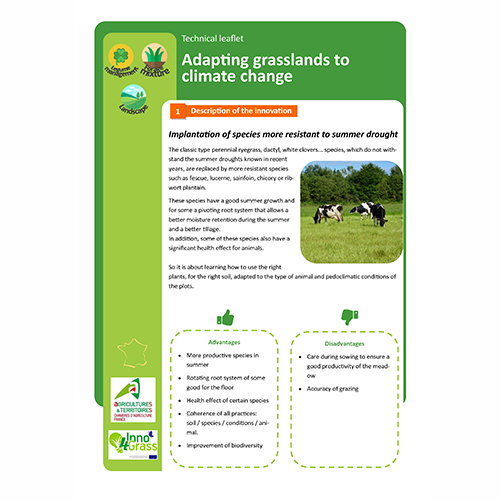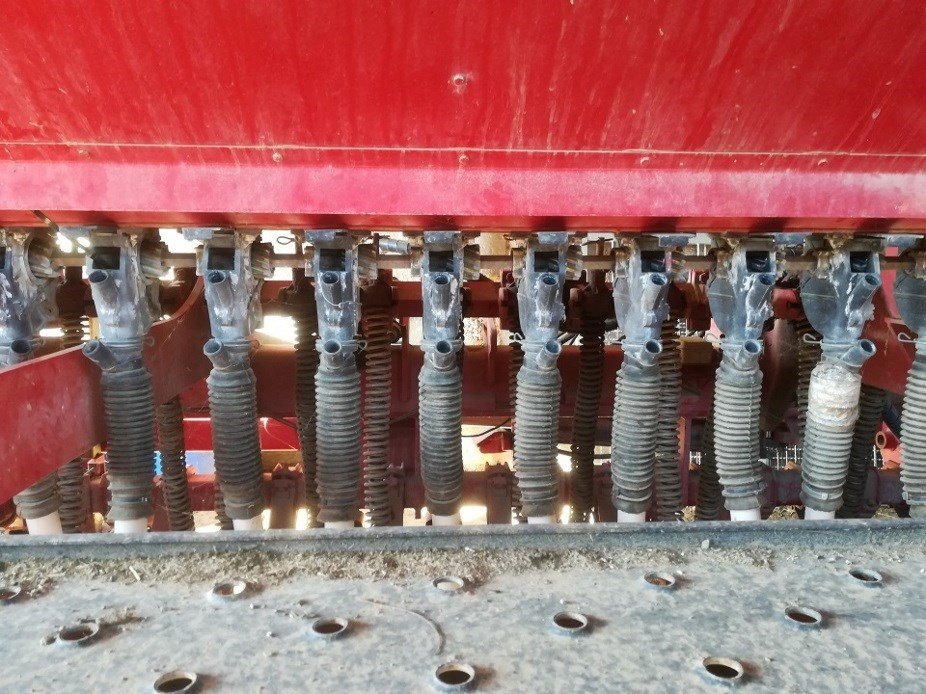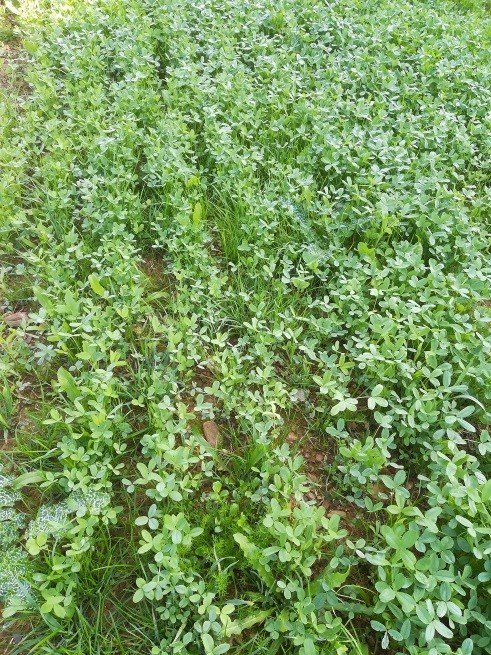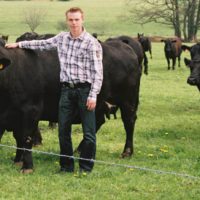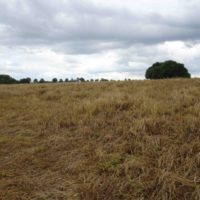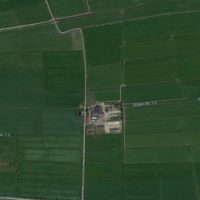Description
Description of the innovation
Sod-seeding is conveniently used in a farm under Mediterranean climate with forage species. To apply correctly this technique, the farmers allow weeds to germinate after a rainfall of 20-30 mm at the end of summer and then, they carry out a chemical weeding with a glyphosate-based herbicide at low doses per hectare (2 l ha-1). Afterwards, they sow forage species by means of a disc seeder. This latter was preferred to a narrow-knife seeder because it is more suitable for the almost flat, deep sandy-clay soils which can be found in the farm. Stones in farm soils were removed over the years to reduce damage to the seeder working organs. Before adopting direct seeding, traditional ploughing and refining works were carried out at the end of summer (August). Then, seeding was carried out in September, and the seed germination took place after the first rains in autumn.
The sod-seeder used by the farmers (Semeato, mod. TDNG 520 SEED) has been designed for small grains and weights 9 tons. It is equipped with a seed box that can contain 2000 kg of seeds. The number of rows seeded is 32 x 17 cm (7 m width).
It is used with a 130 Hp tractor. The daily operational capacity is 30 ha. Another sod-seeder is used in the farm with corn seeds (Semeato, mod. SPE 06 vacuum system). Corn is sown in the farm as double cropping.
Results obtained with the adoption of the innovation
Despite farmers adopted sod-seeding successfully with the main objective to reduce the time spent to manage seeding, they currently think that the main result they achieved is the possibility to seed promptly when the best soil conditions are met (timeliness of seeding). At the same time, the time-window for sod-seeding is very rigid, because seeding can be carried out only with the proper water content in the soil. Consequently, the farmers developed a deep knowledge of their farm soils to carry out this agricultural practice in a successful way. Currently, it takes 7-10 days to complete the seeding of forage species vs 30-40 days of conventional soil tillage.
Another result achieved by farmers is the general reduction of costs The main component of cost reduction is related to fuel consumption. The sod-seeding, including chemical weeding, requires at most 15 l of fuel per hectare vs 70-80 l required by traditional soil tillage, fertilisation, seeding and rolling. The money saving is equal to 60–80 euro ha-1, at current fuel price.
Other savings for the farmers are related to the low maintenance of the sod-seeder compared to the traditional machinery for soil tillage. In fact, sod-seeders are subject to less wear-and-tear during the use. Conversely, the farmers spent a high amount of money to buy the sod-seeder (about 80,000 euros).
Further cost savings derived from the sowing of legume-based forage mixtures in-stead of cereals, that reduced the need for nitrogen fertilisers and the seed amounts per hectare. Currently, the forage mixtures used are based on annual clovers (Trifolium alexandrinum, T. squarrosum, T. incarnatum) and Italian ryegrass (Lolium multiflorum), sown at a seed rate of 50 kg ha-1. The forage yield was slightly lower than the potential in the first 2-3 years of direct seeding, then it varied from year to year but now, it is comparable or higher to the average yield per hectare of the region and the traditional soil tillage crops (6.0-7.0 t ha-1).
The farmers suggested to test forage species and varieties best adapted to be direct-seeded in the specific farm conditions, because they assessed that some of them do not germinate in all soils types. On the basis of their experience, this is the case of oat and Italian ryegrass.
Another benefit related to the use of sod-seeding in the farm is the higher soil water content in spring, which was quantified in +40% compared to conventional tillage. This is quite important in the Mediterranean region, because rainfall is often low in spring and forage and grain crops can take great advantage of available water in soil during their growth stage.
The farmers have used sod-seeding of forage mixtures for hay production or sheep grazing. In both cases, soil showed a greater bearing capacity during rainy periods and an improved structure thanks to their higher organic matter content. At the same time, soils showed tendency towards compaction over years. This is why a minimum tillage is required after 3-4 years of grazing in direct-seeded pastures.
If direct-seeded forage crops are grown for grazing, the farmers recommend to accurately plan the seeding periods to have an adequate grass availability for grazing animals at the beginning of the season (autumn). In fact, grazing of direct-seeded pastures is delayed of 15-20 days, compared to traditional soil tillage. This delay is due to the lower growth rate of direct-seeded grass, which persists as long as roots are poorly developed.
Grazing of sod-seeded grasslands is a good choice if weeding has not been perfectly managed before direct seeding. In fact, the presence of unsown species can be reduced by grazing animals. Sheep grazing is preferred in this case by farmers. From this point of view, grazing can improve the sustainability of sod-seeding allowing a reduced use of glyphosate-based herbicides, except for the presence of rhizomatous weeds and thorny species.
Sod-seeding can be used also to overseed grasslands (see Saba farm). In the Saba farm, a three-year old stand of lucerne was over-seeded with Italian ryegrass at the end of summer, after the last seasonal harvest of lucerne, with the aim to increase plot production and take advantage of the residual nitrogen in the soil. This plot was used for sheep grazing during winter, when other pasture was not available. Lucerne productivity in the subse-quent year was not negatively influenced by sheep grazing and Italian ryegrass cultivation.
Advantages
- Timeliness of seeding is the most important advantage
- Cost reduction (fuel, manpower)
- Lower seed rates per hectare
- Higher water content in soils (up to + 40%)
- High carbon content in soil
- Greater soil bearing capacity dur-ing rainy periods
- Lower levels of organic matter oxidation, especially in sandy soils
- It can be used to overseed peren-nial grasslands with annual spe-cies (i.e. Ryegrass over lucerne)
- Sod-seeders have a low mainte-nance cost
Disadvantages
- The use of herbicides (glyphosate) is mandatory for the success of crops, especially in the presence of rhizomatous weeds
- The availability of the appropriate seeder is required depending on the soil characteristics
- Not all forage species are suitable to be sod-seeded
- Clay and heavy soils are not well suited to this technique
- At establishment, the growth rate of grass is slower if compared to traditional sowing
- A problem to cope with is soil compaction and waterlogging
- Sod-seeders are very expensive (80k euros and more), especially for small farms.
More information
- http://agricoltura.regione.emilia-romagna.it/archivio-agricoltura/2016/dicembre-2016/supplemento-n-63-dicembre-2016
- http://www.sardegnaagricoltura.it/documenti/14_43_20180720095900.pdf
- http://www.sardegnadigitallibrary.it/index.php?xsl=2436&s=17&v=9&c=4460&id=676698
- https://iris.unito.it/retrieve/handle/2318/1680259/448735/Ferrero%20et%20al.%20-%202018%20-%20Alternative%20al%20glifosate%20nelle%20colture%20erbacee.pdf
- Vásquez de Aldana, B.R.; García Ciudad A.; Garcia Criado, B.; 2006. Biomass production and protein content of semiarid grasslands in western Spain over a 20-years period. In: Sustainable Grassland Productivity Proceedings of
